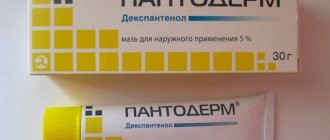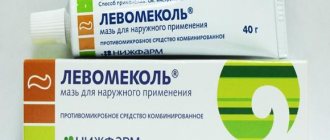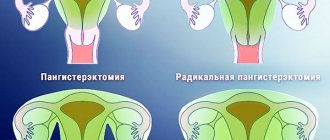Endometriosis is a hormone-dependent disease in which endometrial tissue grows beyond its normal location.
The origin of the disease has not been established, but there are several theories, the most likely of which is a hormonal imbalance or a malfunction in immune homeostasis.
Some forms of the disease are considered hereditary.
The fact that endometriosis is most likely a disease caused by a hormonal imbalance is confirmed by the absence of this pathology before the end of puberty, as well as after the onset of menopause.
What is endometriosis
Endometriosis of the uterus is a benign, however, quite serious disease. This is not a tumor or a malignant process, but in all its characteristics the disease is similar to a tumor formation.
Read more about what endometriosis is here.
IMPORTANT!
If endometriosis is not treated promptly and competently, in rare cases it can transform into oncology.
The inside of the uterus is covered with a layer of epithelial cells, which normally do not leave the reproductive organ and do not grow deep into the uterine layer.
Adenomyosis
is one of the most common forms of the disease, in which endometrial cells move deeper into the myometrium.
There is also another form of the disease, the so-called extragenital - in this case, endometrial cells leave the reproductive organ and affect neighboring organs, even very distant ones. This process is carried out by throwing endometrial cells into the abdominal cavity during heavy menstruation or during surgery.
These cells are characterized by the preservation of all their functions, no matter where they are located. That is, every month with the onset of menstruation, they are rejected and provoke hematomas in the tissues of the affected organs.
During this period, the woman’s condition worsens sharply, since tissue swelling provokes organ dysfunction with endometriosis. After menstruation ends, the woman feels better and all unpleasant symptoms subside.
However, chronic inflammation causes the formation of adhesions, which gradually begin to interfere with the functioning of organs.
Despite the fact that doctors still do not know the cause of the disease, they have identified risk factors that may contribute to the development of the disease:
- heredity;
- inflammatory and infectious diseases of the genital organs;
- the presence of an intrauterine device;
- frequent abortions, difficult childbirth, operations on the reproductive organs;
- C-section.
The question arises - why does the immune system not attack cells growing in places where they should not be? This question can be answered by taking into account a woman’s genetic predisposition to this disease - only those endometrial cells that have certain innate properties determined by the presence of certain genes survive outside the uterine cavity.
Therefore, if a woman has had cases of endometriosis in her family and has inherited a certain endometrial genotype, her risk of developing the disease is extremely high.
Indications for use in gynecology
Due to the fact that methyluracil promotes the rapid restoration of cellular structures, in gynecology these suppositories are mainly prescribed for healing wounds, sutures and eliminating inflammatory diseases of the genital organs. Thus, the indications for use are the following conditions and pathologies:
- colpitis and vaginitis (inflammation of the mucous membranes of the vagina);
- trauma to the cervix and vagina;
Methyluracil suppositories are widely used for inflammatory diseases, in particular cervicitis
Methyluracil can be used by elderly patients when age-related changes appear to increase the elasticity and strengthen the vaginal muscles.
https://youtu.be/C7ONdy-QLZI
Symptomatic manifestations
Endometriosis is accompanied by vague symptoms, to which a woman often simply does not react properly because she associates the unpleasant symptoms with the menstrual cycle.
As a rule, women consult a doctor only if there is bleeding, persistent early miscarriages, or persistent infertility.
Therefore, endometriosis, especially in its early stages, is usually diagnosed during preventive gynecological examinations or when diagnosing other diseases of the reproductive system.
Symptoms of endometriosis
manifest as follows:
- pain in the pelvic and lumbar region, which most often intensifies during the premenstrual period. The difference between periodic menstrual pain and pain with endometriosis is that with the disease, pain occurs every month for six months or more ;
- discomfort during sexual intercourse;
- bloody premenstrual and postmenstrual discharge;
- excessive menstrual bleeding, during which a woman develops anemic syndrome;
- miscarriages or infertility;
- presence of PMS;
- breakthrough intermenstrual bleeding.
Advantages and contraindications
Vaginal or rectal suppositories are preferable in the treatment of the initial stages of endometriosis than drugs in tablet form. This is due to the fact that the active components of the drug immediately penetrate the mucous membranes of the reproductive system, providing a rapid anti-inflammatory and analgesic effect.
Suppositories act immediately after their insertion into the vagina, while tablets need from 30 minutes to 2 hours for their components to reach the site of the inflammatory process through the circulatory system. In addition, the use of anti-inflammatory suppositories for endometriosis has a lower risk of side symptoms than tablets.
At the discretion of the attending physician, the rectal or vaginal route of administration of the drug is recommended. If the disease is accompanied by frequent and heavy bleeding, vaginal suppositories are not used, since their components will be washed away by the escaping blood before they have time to be absorbed into the mucous membranes. In this regard, suppositories are most often prescribed for rectal administration.
The use of suppositories has a number of contraindications:
- pregnancy and lactation;
- individual allergic reactions to certain components of the drug;
- glaucoma;
- cardiopalmus;
- chronic liver and kidney diseases.
Possible side symptoms: sleep disturbance, muscle contractions, depressed emotional state, drowsiness, headaches, dizziness.
Hormonal drugs
The main goals of drug treatment for endometriosis are:
- suppression of ovarian functionality;
- inhibition of ovulatory processes;
- hypoestrogen induction;
- elimination of pathological foci of the disease.
Treatment with hormonal drugs is used quite widely due to the high effectiveness of this group of drugs and extremely low risks.
The following drugs are prescribed for the treatment of endometriosis:
- antiprogestins – Danazol , Mifepristone . These drugs suppress the synthesis of gonadotropin, which leads to drug-induced amenorrhea:
- GnRH agoists – Buserelin , Goserelin . These drugs affect the pituitary gland and hypothalamus, causing suppression of the secretion of pathological foci, which leads to atrophic phenomena in them;
- hormonal contraceptives - Zhanine , Yarina , Diane-35 , Klaira ;
- gestagens, for example Duphaston , are a hormonal drug whose action is aimed at regulating progesterone deficiency. Duphaston normalizes the functionality of the woman’s genital organs.
IMPORTANT!
Hormonal drugs for uterine endometriosis are recommended to be taken for a limited amount of time, this is due to the fact that this group of drugs has a large number of side effects. Therefore, independent and uncontrolled use of hormones is unacceptable.
Personal experience “I felt like I was in hell”: How I live with endometriosis
Everything was fine with this drug - except that it is very powerful and has a lot of side effects, and it is usually prescribed for several months. Essentially, it puts the body into an artificial menopause. I took the medicine for a year and felt great, but because of the risks associated with it, I was told to stop taking it. Within a month, I realized that something had changed inside, I went for an ultrasound and saw new nodes on the screen. This was a couple of months before the defense of my thesis collection. For almost a month I lay at home and cried. I don’t remember what pulled me out of that state then, I remember that I read the book “Depression is Canceled” and forced myself to leave the house. It seemed that the world had closed in, there was nothing to breathe. Then something clicked in my head, and I looked at the situation from the outside. Then we broke up with the young man, I stopped crying and was able to finish the collection and get a diploma.
I worked a lot, arranged some filming, went to German courses, and in general I had no time for doctors. My stomach began to hurt again, I started taking pills, and one evening, when I was at home alone, the pain suddenly surged in an instant, my legs gave way, and I simply rolled down the wall in the hallway. Dad arrived from Komarov faster than an ambulance. I called the doctors at eight o'clock, and they took me away only around eleven, saying that most likely it was appendicitis. By midnight I was at the first medical institute, where everything is beautiful, like in American TV series about doctors. They put me on a gurney and took me to rescue. Only bad luck - they quickly realized that it was gynecology, not appendicitis, and the gynecological wing was under repair. As a result, I waited in the emergency room to go to another hospital. Pain relief was not allowed in order to preserve the picture of symptoms for the next doctors. I was pounding, my teeth were chattering, and for the first time in my life I howled in pain. As a result, when I finally ended up in the hospital, I was treated with antibiotics, relieving the “inflammation of the appendages.”
In January, I was sent to a new surgeon in Moscow, saying that such complicated cases should be dealt with by the brightest luminaries. I went there several times for appointments, received a federal quota for the operation and received it by April. They sent me all the documents and set a date for hospitalization. A few days before departure, I called the surgeon’s assistant and he clarified the details. I arrived there by night train with all my things, and when I went to the doctor’s office in the morning, she said that she was on vacation starting tomorrow, and then she would start working at another hospital. An anecdote according to Kant: intense expectation that suddenly turned into nothing. She didn't understand what the problem was; her assistant timidly said that I came from another city, to which she replied that it was not scary, “she will come again.” I sobbed in the corridor, not understanding how to react to this. I went to Pushkinsky, looked at the Cranachs and returned home. I understood that no matter how cool and famous this doctor was, I would not go to her operating table - I no longer trusted her.
Non-hormonal agents
Hormone-free products are prescribed for the symptomatic treatment of endometriosis.
As a rule, these are the following groups of drugs:
- immunomodulators – Viferon , Cycloferon , Roncoferon and others;
- antioxidants – tocopherol acetate , Pycnogenol , ascorbic acid ;
- antispasmodics – No-shpa , drotaverine hydrochloride ;
- tranquilizers - Tazepam , Seduxen , Phenazepam ;
- iron preparations – Fenyuls , Ferroplex ;
- phytohormones – Cyclodinone ;
- anti-inflammatory drugs, antibiotics and hemostatic drugs.
Using candles
Suppositories are the most effective and convenient form for the treatment of many gynecological diseases, including endometriosis and uterine fibroids.
However, in many cases it is difficult to treat endometriosis with suppositories due to bleeding or spotting. In this case, the active substance of the suppository is washed out, and the effectiveness of such therapy is zero.
But if a woman does not experience bleeding or discharge, she is prescribed the following suppositories:
- Anuzol;
- Diclovit;
- Indomethacin;
- Viferon;
- suppositories with propolis;
- candles with sea buckthorn oil.
NOTE!
Suppositories with propolis and sea buckthorn oil are prescribed as additional therapy. These non-hormonal suppositories have hemostatic, antispasmodic and anti-inflammatory effects, but for more effective treatment they are prescribed in combination with other drugs.
Side effects
The use of anti-inflammatory, immunomodulatory, analgesic and absorbable suppositories can provoke the development of adverse reactions in the female body.
Side effects when treating endometriosis with suppositories may include:
- skin rash, which acts as an allergic reaction;
- disorders of the gastrointestinal tract (constipation, indigestion, etc.);
- sleep disorders;
- convulsions;
- headaches that turn into migraines;
- dizziness;
- psycho-emotional disorders (mood swings, tendency to depression);
- general malaise of the body;
- muscle weakness;
- fast fatiguability;
- urinary retention.
These body reactions can accompany the use of suppositories, both in combination and individually.
In some situations, an overdose of the active substance is possible. The body's response will include vomiting, hyperthermia, increased emotional arousal, convulsions and headache. If during the course of treatment one of the signs of an overdose is noticed, you should immediately inform your doctor and stop taking the drug. The doctor should adjust the subsequent dose or prescribe another medicine.
Popular drugs
What drugs are the most popular in the treatment of endometriosis? Let's take a closer look at them.
Byzanne
One of the most common drugs for the treatment of endometriosis in women of reproductive age is Visanne.
These tablets are contraindicated for use in postmenopausal women, as well as girls under 18 years of age.
Visanne is prescribed to patients with grades 1 and 2 of the disease; it is also advisable to take it as maintenance therapy after surgical treatment of endometriosis.
Visanne is taken for six months according to a regimen that will be described in detail by the attending physician.
Effects of taking the drug:
- anesthesia;
- normalization of the menstrual cycle;
- improving the structure of the endometrium;
- stabilization of hormonal levels;
- suppression of the growth of blood vessels supplying endometrial tissue;
- elimination of endometrial cells in the wrong place.
Zoladex
Another popular treatment for endometriosis is Zoladex. It alleviates pain symptoms and reduces the number and size of pathological foci of endometriosis.
The drug is produced in the form of capsules, which are injected subcutaneously into the abdominal wall.
The drug has an analogue, Goserelin, which has the same effects, but replacing Zoladex with analogues is possible only after consulting a doctor.
Indomerol
Indomerol is a complex preparation of natural antioxidants and estrogens that effectively stabilizes hormonal levels.
This medicine is most often prescribed in combination with Epigplaom for a period of 6 months.
CAREFULLY!
All of the medications listed have contraindications, so self-administration of medications is prohibited.
Endometriosis: description of the disease and signs
Before we talk about what suppositories are used for endometriosis, let’s figure out what this disease is. It is characterized by the spread of endometrial cells beyond the inner layer of the uterus.
It is noteworthy that the disease spreads very quickly. This is precisely why it is dangerous, since in a short period it can affect many organs. There are cases when this disease even affected the lungs, how quickly the tissues spread throughout the body.
The endometrium is a functional tissue. Its structure contains special receptors for hormones. This tissue is identical to that found in the normal endometrium and is manifested by bleeding during menstruation.
In its normal state, this tissue is not at all dangerous, since it is simply excreted from the body. However, if a malfunction occurs and it enters the body, the picture changes.
Regardless of which area the tissue is fixed, it will negatively affect the woman’s health. The disease can even lead to organ dysfunction, which is very dangerous.
Diagnosing endometriosis at an early stage is almost impossible. Especially if a woman does not visit the gynecologist very often. In the first stages, the course of the disease is completely asymptomatic, so it is extremely difficult to suspect that a negative process is developing in the body.
Only when endometriosis affects a large area will certain symptoms begin to appear. Or rather, there is only one symptom. And this is pain that can be constant nagging and paroxysmal.
Suppositories for endometriosis











